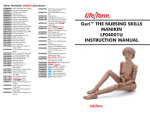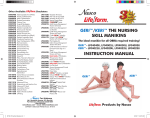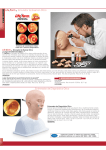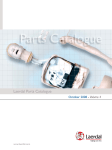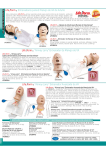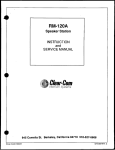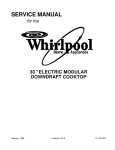Download Manual - WorldPoint
Transcript
Other Available LF00698U LF00856U LF00901U LF00906U LF00929U LF00957U LF00958U LF00961U LF00984U LF00995U LF00997U LF00999U LF01008U LF01012U LF01019U LF01020U LF01025U LF01026U LF01027U LF01028U LF01036U LF01053U LF01054U LF01062U LF01063U LF01064U LF01068U LF01069U LF01070U LF01082U LF01083U LF01084U LF01087U LF01094U LF01095U LF01108U LF03000U LF03601U LF03602U LF03603U LF03609U Adult Injectable Arm (White) Female Catheterization Prostate Examination Ostomy Care Surgical Bandaging Enema Administration Pediatric Injectable Arm Intramuscular Injection Breast Examination Arterial Puncture Arm Adult Injectable Arm (Black) Pediatric Injectable Head Intradermal Injection Arm Heart Catheterization (TPN) Ear Examination Supplementary Ear Set Male Cath-Ed I Female Cath-Ed II Peritoneal Dialysis Suture Practice Arm Spinal Injection Cross-Sectional Anatomy, Torso, Head Cross-Sectional Anatomy, Head Pelvic, Normal & Abnormal Stump Bandaging, Upper Stump Bandaging, Lower Brachial Plexus Cervical Effacement Birthing Station Cricothyrotomy Tracheostomy Care Sigmoidoscopic Examination Central Venous Cannulation Cross Sectional Anatomy — Laminated Blood Pressure Arm Intraosseous Infusion Simulator CPARLENE® Series Adult Airway Management Trainer Adult Airway Management on Manikin Adult Airway Management Head Only Child Airway Management Trainer Simulators LF03610U Child Airway Management Trainer Head Only LF03611U Child Defibrillation Chest Skin LF03612U Child IV Arm LF03613U Child Blood Pressure Arm LF03614U Child Intraosseous Infusion/ Femoral Access Leg Only LF03615U Complete Child CRiSis™ Update Kit LF03616U Child CRiSis™ Manikin LF03617U Deluxe Child CRiSis™ Manikin with Arrhythmia Tutor LF03620U PALS Update Kit LF03621U Infant Airway Management Trainer Head Only LF03622U Intraosseous Infusion Right Leg LF03623U Infant Airway Management Trainer LF03626U Child Femoral Access Injection Pad Replacement LF03627U Child CRiSis™ Replacement Lung Set LF03628U Child CRiSis™ Replacement Stomach LF03629U Child IV Arm Replacement Skin and Veins LF03630U Child Arrhythmia Tutor LF03631U Child Airway Management Trainer Replacement Headskin LF03632U Child Intraosseous Infusion/ Femoral Access Leg on a Stand LF03633U Child Airway Management Trainer with Torso LF03650U CRiSis™ Manikin LF03651U ALS Update Kit LF03675U BLS Manikin — 10 Pack LF03676U BLS Manikin — 5 Pack LF03677U BLS Manikin — Single LF04001U GERi™ Nursing Manikin LF04020U KERi™ Nursing Manikin LF04021U KERi™ Basic Manikin LF04022U KERi™ Advanced Manikin LF04030U GERi™ Advanced Manikin LF04040U GERi™ Basic Manikin ADVANCED INJECTION HAND LF01139U & LF01146U INSTRUCTION MANUAL Fort Atkinson 901 Janesville Avenue, P.O. Box 901 Fort Atkinson, Wisconsin 53538-0901 (920) 563-2446 www.eNASCO.com • E-Mail [email protected] COPYRIGHT © NASCO 1999 PRINTED IN U.S.A. NP 104-99 Products by NASCO Cautions 1. This synthetic blood is specially formulated to be compatible with the self-sealing veins and plastics used in manufacturing the arm. 2. DO NOT use dull or burred needles as these will cause leaks in the system. Burred needles will cause permanent damage. Use smaller needles (20- to 25-gauge). 3. DO NOT allow “blood” to dry on the simulator — it may stain the hand. LF00845U Life/form® Arterial Blood, 1 quart LF00846U Life/form® Arterial Blood, 1 gallon LF01099U Vein Tubing Sealant Kit LF01130U Fluid Supply Bag LF01139U Advanced Injection Hand (White Skin) LF01140U White Replacement Skin & Vein Installation Kit LF01141U Replacement Vein Only 4. Use only 500cc of infusion fluid as a larger amount will also increase the pressure of the venous system, resulting in leaks. LF01146U Advanced Injection Hand (Black Skin) 5. DO NOT clean the simulator with solvents or corrosive material as they will damage it. SB29863U Fluid Supply Stand 6. The NASCO Vein Tubing Sealant Kit (LF01099U) will extend the useful life of the tubing. List of Components 3cc syringe with needle 12cc syringe with needle 2 IV bags Needle (butterfly) 2 pinch clamps 2 small towels Infusion set (butterfly) Supplies/Replacement Parts for the Injectable Training Hand LF01147U Black Replacement Skin and Vein Installation Kit W09919U REN Cleaner Internal Structure About the Simulator… The Life/form ® Advanced Injection Hand Simulator duplicates the human condition as closely as modern plastics technology allows — it is almost the real thing. Its care and treatment should be the same as with a patient; abuse or rough handling will damage the simulator — just as it would cause pain or injury to a patient. This unit is the simulation of the entire human hand from the wrist to the fingertips. Externally the skin texture is realistic to the touch and the fingertips actually have fingerprints. Although this hand will provide you long trouble-free usage, the skin and veins can be readily replaced when needed. The outer skin is easily peeled off revealing the “core” and veins providing, literally, a brand new hand. The life of the replaceable skin and veins will be prolonged by utilizing smaller needle sizes (such as 20- to 25-gauge). However, if instruction with larger needle sizes is required, this can be done; the skin and veins will merely need to be replaced sooner. Replacement Skin and Vein Kits are available through NASCO (see list of supplies). Figure 1 Internally the vascular structure (rubber tubing) includes injectable metacarpal, digital, and thumb veins. The venous system is constructed of special self-sealing rubber tubing with the lumen being the approximate size of a human vein (Figure 1). The vascular structure has an inlet tube and an outlet tube below the wrist and it is via these tubes that the venous system is filled. Thus, the techniques of blood drawing and starting intravenous infusions may be practiced on the Advanced Injection Hand. General Instructions for Use The Advanced Injection Hand comes with all of the supplies necessary to perform most procedures. (To perform intravenous infusions the user must supply their own IV set and bag of solution.) B. Preparing the Hand for Intravenous Infusions (At this point you will need to supply an IV set and bag of solution. Hook them up and have them ready.) A B 1. To hook up the hand, refer back to steps 1-5 in section A. 2. Insert the butterfly needle into a vein. Flashback will indicate proper insertion. Figure 3 Figure 2 A. Preparing the Synthetic Blood 1. Add 1 pint of distilled water to the synthetic blood concentrate (Figure 2). 2. Hang one of the bags (bag A) approximately 28" above the level of the hand, making sure the clamp on the IV tubing is closed. Pour the blood into the bag. 3. Attach the fitting end of the IV tubing to one of the wrist tubes. Important Note: Before completing step 4, bag B must lie at hand level or below with the cap closed. 4. With the other wrist tube attached to the empty IV bag (bag B), flush the vascular system with synthetic blood by opening the clamp of the filled IV bag (bag A). (Figure 3) Allow some blood to pass through the system until the outlet wrist tube to bag B runs free of bubbles. When the outlet tubing to bag B runs clear of bubbles, close the clamp on bag B. 5. The venous system is now full of “blood” and pressurized. Be sure to leave the clamp on the inlet tubing (bag A) opened. 6. The hand is now ready to practice drawing blood. “Blood” can be drawn anywhere along the pathway of the vein (see Figure 1). Distilled water should be used to prepare the sites. Synthetic blood will actually be aspirated once the vein is properly punctured. 7. Small diameter needles (20- to 25gauge) should be used. 3. If a flashback is observed, close the clamp on IV bag A. You are now ready to set up for the intravenous infusion. 4. Hang the IV solution bottle and connect the IV set to the butterfly needle already in the vein. With the clamp on bag A closed, open the clamp on bag B. Proof of the proper procedure is evidenced by the flow of the infusion fluid from the solution bag. Control the flow from the solution bag by adjusting the roller clamp on the tubing of the IV set. Causes for Failure in Function A. Forgotten closed clamp. B. Kinks in tubing of the fluid bags. C. Tubing pinched shut by constant pressure of clamps. Lumen remains pinched occasionally even if the clamp is loosened. Slide clamp to new position and with fingers manipulate tubing at pinched site to restore lumen. In heavy use, slide clamp to new position on tubing from time to time to prevent the “permanent pinch” caused by constant clamp pressure. D. If these measures do not unclog the venous system, try using a large (50cc) syringe to force fluid through the tubing. Care of Simulator After each class use, close the clamps, disconnect bags, and return synthetic blood to storage container. Reconnect one IV bag to the system. Fill the bag with tap water and flush the venous system, allowing the open end to drain into a sink or basin. When the system runs clean, close the clamp and remove the IV bag. Excess water may be removed from the hand by raising the hand, lowering the wrist, and draining it into a sink or basin. Wash the outside of the hand with Ivory® liquid detergent and water. Always remove the pinch clamps from the wrist tubing and drain excess water from veins before storing. Ordinary stains can be removed by washing the hand with soap and warm water. Newsprint, similar printed paper or ink will permanently stain the simulator if prolonged contact occurs. Stubborn stains may be removed with REN Cleaner (W09919U), simply by dispensing it on the area and wiping with a soft cloth or paper towel. General Instructions for Use The Advanced Injection Hand comes with all of the supplies necessary to perform most procedures. (To perform intravenous infusions the user must supply their own IV set and bag of solution.) B. Preparing the Hand for Intravenous Infusions (At this point you will need to supply an IV set and bag of solution. Hook them up and have them ready.) A B 1. To hook up the hand, refer back to steps 1-5 in section A. 2. Insert the butterfly needle into a vein. Flashback will indicate proper insertion. Figure 3 Figure 2 A. Preparing the Synthetic Blood 1. Add 1 pint of distilled water to the synthetic blood concentrate (Figure 2). 2. Hang one of the bags (bag A) approximately 28" above the level of the hand, making sure the clamp on the IV tubing is closed. Pour the blood into the bag. 3. Attach the fitting end of the IV tubing to one of the wrist tubes. Important Note: Before completing step 4, bag B must lie at hand level or below with the cap closed. 4. With the other wrist tube attached to the empty IV bag (bag B), flush the vascular system with synthetic blood by opening the clamp of the filled IV bag (bag A). (Figure 3) Allow some blood to pass through the system until the outlet wrist tube to bag B runs free of bubbles. When the outlet tubing to bag B runs clear of bubbles, close the clamp on bag B. 5. The venous system is now full of “blood” and pressurized. Be sure to leave the clamp on the inlet tubing (bag A) opened. 6. The hand is now ready to practice drawing blood. “Blood” can be drawn anywhere along the pathway of the vein (see Figure 1). Distilled water should be used to prepare the sites. Synthetic blood will actually be aspirated once the vein is properly punctured. 7. Small diameter needles (20- to 25gauge) should be used. 3. If a flashback is observed, close the clamp on IV bag A. You are now ready to set up for the intravenous infusion. 4. Hang the IV solution bottle and connect the IV set to the butterfly needle already in the vein. With the clamp on bag A closed, open the clamp on bag B. Proof of the proper procedure is evidenced by the flow of the infusion fluid from the solution bag. Control the flow from the solution bag by adjusting the roller clamp on the tubing of the IV set. Causes for Failure in Function A. Forgotten closed clamp. B. Kinks in tubing of the fluid bags. C. Tubing pinched shut by constant pressure of clamps. Lumen remains pinched occasionally even if the clamp is loosened. Slide clamp to new position and with fingers manipulate tubing at pinched site to restore lumen. In heavy use, slide clamp to new position on tubing from time to time to prevent the “permanent pinch” caused by constant clamp pressure. D. If these measures do not unclog the venous system, try using a large (50cc) syringe to force fluid through the tubing. Care of Simulator After each class use, close the clamps, disconnect bags, and return synthetic blood to storage container. Reconnect one IV bag to the system. Fill the bag with tap water and flush the venous system, allowing the open end to drain into a sink or basin. When the system runs clean, close the clamp and remove the IV bag. Excess water may be removed from the hand by raising the hand, lowering the wrist, and draining it into a sink or basin. Wash the outside of the hand with Ivory® liquid detergent and water. Always remove the pinch clamps from the wrist tubing and drain excess water from veins before storing. Ordinary stains can be removed by washing the hand with soap and warm water. Newsprint, similar printed paper or ink will permanently stain the simulator if prolonged contact occurs. Stubborn stains may be removed with REN Cleaner (W09919U), simply by dispensing it on the area and wiping with a soft cloth or paper towel. Other Available LF00698U LF00856U LF00901U LF00906U LF00929U LF00957U LF00958U LF00961U LF00984U LF00995U LF00997U LF00999U LF01008U LF01012U LF01019U LF01020U LF01025U LF01026U LF01027U LF01028U LF01036U LF01053U LF01054U LF01062U LF01063U LF01064U LF01068U LF01069U LF01070U LF01082U LF01083U LF01084U LF01087U LF01094U LF01095U LF01108U LF03000U LF03601U LF03602U LF03603U LF03609U Adult Injectable Arm (White) Female Catheterization Prostate Examination Ostomy Care Surgical Bandaging Enema Administration Pediatric Injectable Arm Intramuscular Injection Breast Examination Arterial Puncture Arm Adult Injectable Arm (Black) Pediatric Injectable Head Intradermal Injection Arm Heart Catheterization (TPN) Ear Examination Supplementary Ear Set Male Cath-Ed I Female Cath-Ed II Peritoneal Dialysis Suture Practice Arm Spinal Injection Cross-Sectional Anatomy, Torso, Head Cross-Sectional Anatomy, Head Pelvic, Normal & Abnormal Stump Bandaging, Upper Stump Bandaging, Lower Brachial Plexus Cervical Effacement Birthing Station Cricothyrotomy Tracheostomy Care Sigmoidoscopic Examination Central Venous Cannulation Cross Sectional Anatomy — Laminated Blood Pressure Arm Intraosseous Infusion Simulator CPARLENE® Series Adult Airway Management Trainer Adult Airway Management on Manikin Adult Airway Management Head Only Child Airway Management Trainer Simulators LF03610U Child Airway Management Trainer Head Only LF03611U Child Defibrillation Chest Skin LF03612U Child IV Arm LF03613U Child Blood Pressure Arm LF03614U Child Intraosseous Infusion/ Femoral Access Leg Only LF03615U Complete Child CRiSis™ Update Kit LF03616U Child CRiSis™ Manikin LF03617U Deluxe Child CRiSis™ Manikin with Arrhythmia Tutor LF03620U PALS Update Kit LF03621U Infant Airway Management Trainer Head Only LF03622U Intraosseous Infusion Right Leg LF03623U Infant Airway Management Trainer LF03626U Child Femoral Access Injection Pad Replacement LF03627U Child CRiSis™ Replacement Lung Set LF03628U Child CRiSis™ Replacement Stomach LF03629U Child IV Arm Replacement Skin and Veins LF03630U Child Arrhythmia Tutor LF03631U Child Airway Management Trainer Replacement Headskin LF03632U Child Intraosseous Infusion/ Femoral Access Leg on a Stand LF03633U Child Airway Management Trainer with Torso LF03650U CRiSis™ Manikin LF03651U ALS Update Kit LF03675U BLS Manikin — 10 Pack LF03676U BLS Manikin — 5 Pack LF03677U BLS Manikin — Single LF04001U GERi™ Nursing Manikin LF04020U KERi™ Nursing Manikin LF04021U KERi™ Basic Manikin LF04022U KERi™ Advanced Manikin LF04030U GERi™ Advanced Manikin LF04040U GERi™ Basic Manikin ADVANCED INJECTION HAND LF01139U & LF01146U INSTRUCTION MANUAL Fort Atkinson 901 Janesville Avenue, P.O. Box 901 Fort Atkinson, Wisconsin 53538-0901 (920) 563-2446 www.eNASCO.com • E-Mail [email protected] COPYRIGHT © NASCO 1999 PRINTED IN U.S.A. NP 104-99 Products by NASCO





